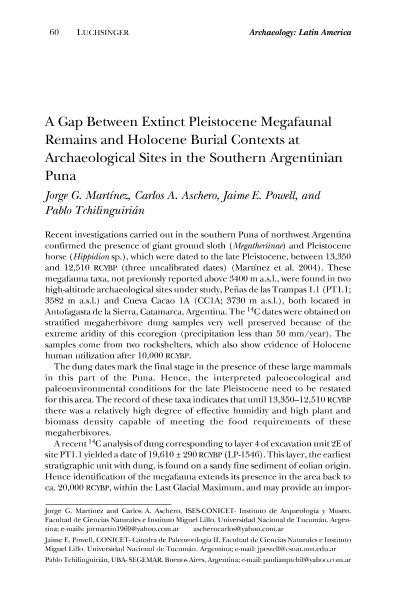Mostrar el registro sencillo del ítem
dc.contributor.author
Martinez, Jorge Gabriel

dc.contributor.author
Aschero, Carlos Alberto

dc.contributor.author
Powell, Jaimie E.
dc.contributor.author
Tchilinguirian, Pablo

dc.date.available
2021-11-05T15:33:49Z
dc.date.issued
2007-12
dc.identifier.citation
Martinez, Jorge Gabriel; Aschero, Carlos Alberto; Powell, Jaimie E.; Tchilinguirian, Pablo; A Gap Between Extinct Pleistocene Megafaunal Remains and Holocene Burial Contexts at Archaeological Sites in the Southern Argentinian Puna; Center for the Study of the First Americans; Current research in the pleistocene; 24; 12-2007; 60-62
dc.identifier.issn
8755-898X
dc.identifier.uri
http://hdl.handle.net/11336/146125
dc.description.abstract
Recent investigations carried out in the southern Puna of northwest Argentina confirmed the presence of giant ground sloth (Megatheriinae) and Pleistocene horse (Hippidion sp.), which were dated to the late Pleistocene, between 13,350 and 12,510 RCYBP (three uncalibrated dates) (Martínez et al. 2004). These megafauna taxa, not previously reported above 3400 m a.s.l., were found in two high-altitude archaeological sites under study, Peñas de las Trampas 1.1 (PT1.1; 3582 m a.s.l.) and Cueva Cacao 1A (CC1A; 3730 m a.s.l.), both located in Antofagasta de la Sierra, Catamarca, Argentina. The 14C dates were obtained on stratified megaherbivore dung samples very well preserved because of the extreme aridity of this ecoregion (precipitation less than 50 mm/year). The samples come from two rockshelters, which also show evidence of Holocene human utilization after 10,000 RCYBP. The dung dates mark the final stage in the presence of these large mammals in this part of the Puna. Hence, the interpreted paleoecological and paleoenvironmental conditions for the late Pleistocene need to be restated for this area. The record of these taxa indicates that until 13,350–12,510 RCYBP there was a relatively high degree of effective humidity and high plant and biomass density capable of meeting the food requirements of these megaherbivores. A recent 14C analysis of dung corresponding to layer 4 of excavation unit 2E of site PT1.1 yielded a date of 19,610 ± 290 RCYBP (LP-1546). This layer, the earliest stratigraphic unit with dung, is found on a sandy fine sediment of eolian origin. Hence identification of the megafauna extends its presence in the area back to ca. 20,000 RCYBP, within the Last Glacial Maximum, and may provide an imporant beginning date for deglaciation at this elevation, which is according to paleoclimatic models designed for the Andean tropical zone (Paduano et al. 2003). In the study area, High-andean steppe is now found at 4200–4800 m a.s.l., but under these conditions, plant biomass likely increased locally with reference to dominant conditions of the glacial maximum
dc.format
application/pdf
dc.language.iso
eng
dc.publisher
Center for the Study of the First Americans
dc.rights
info:eu-repo/semantics/openAccess
dc.rights
Atribución-NoComercial-CompartirIgual 2.5 Argentina (CC BY-NC-SA 2.5 AR)
dc.rights.uri
https://creativecommons.org/licenses/by-nc-sa/2.5/ar/
dc.subject
Contexto arqueológico
dc.subject
Pleistoceno, Holoceno
dc.subject
Puna Argentina
dc.subject.classification
Arqueología

dc.subject.classification
Historia y Arqueología

dc.subject.classification
HUMANIDADES

dc.title
A Gap Between Extinct Pleistocene Megafaunal Remains and Holocene Burial Contexts at Archaeological Sites in the Southern Argentinian Puna
dc.type
info:eu-repo/semantics/article
dc.type
info:ar-repo/semantics/artículo
dc.type
info:eu-repo/semantics/publishedVersion
dc.date.updated
2021-07-26T15:24:38Z
dc.journal.volume
24
dc.journal.pagination
60-62
dc.journal.ciudad
Texas A&M University
dc.description.fil
Fil: Martinez, Jorge Gabriel. Consejo Nacional de Investigaciones Científicas y Técnicas. Centro Científico Tecnológico Conicet - Tucumán. Instituto Superior de Estudios Sociales. Universidad Nacional de Tucumán. Instituto Superior de Estudios Sociales; Argentina
dc.description.fil
Fil: Aschero, Carlos Alberto. Consejo Nacional de Investigaciones Científicas y Técnicas. Centro Científico Tecnológico Conicet - Tucumán. Instituto Superior de Estudios Sociales. Universidad Nacional de Tucumán. Instituto Superior de Estudios Sociales; Argentina
dc.description.fil
Fil: Powell, Jaimie E.. Universidad Nacional de Tucumán. Facultad de Ciencias Naturales e Instituto Miguel Lillo; Argentina
dc.description.fil
Fil: Tchilinguirian, Pablo. Secretaría de Cultura de la Nación. Dirección Nacional de Cultura y Museos. Instituto Nacional de Antropología y Pensamiento Latinoamericano; Argentina
dc.journal.title
Current research in the pleistocene
dc.relation.alternativeid
info:eu-repo/semantics/altIdentifier/url/https://liberalarts.tamu.edu/wp-content/uploads/sites/14/2019/08/2007_v24.pdf
Archivos asociados
